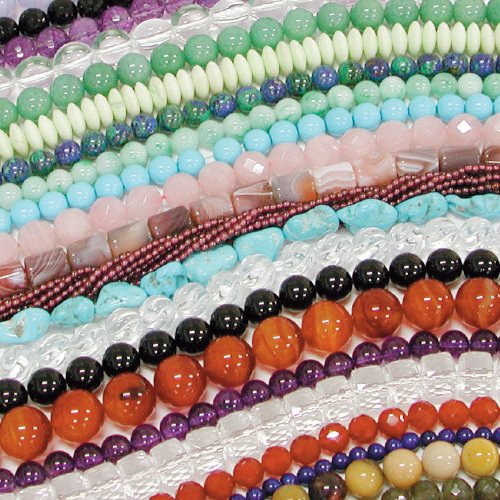|
Gemstones
Articles from GEMSTONES - LOOSE (254 Articles), GEMSTONES - CHRYSOPRASE (40 Articles), GEMSTONE BEADS JEWELLERY (28 Articles)

Ornamental gemstones
Gemstones of décor: ornamental gems
Posted December 01, 2012 |
The minerals and rocks known collectively as the ornamental gemstones
are grouped together because they normally lack transparency. They owe
their attraction to the colour, texture or pattern they possess. Often,
it can even be a mix of these qualities.
All ornamental gems have beauty, but not all are rare. Some have an ancient lineage and have been popular throughout history.
Turquoise and lapis lazuli are valued for their colours, while the attraction in agate lies largely in its pattern.
Most ornamental gems have hardness of seven or less on Moh's scale. The attraction in malachite is in its colour and pattern. Chalcedony is the fine-grained variety of the silica mineral quartz. It has a waxy lustre and appears in a wide colour range – the blue material is amazing.
Chrysoprase is a green variety of chalcedony and its colour, which varies from apple-green to deep green, is due to trace amounts of nickel. Often sold as Australian Jade, it occurs in Marlborough, Queensland and also in Western Australia. Carnelian is the brownish red to orange variety of chalcedony, coloured by the presence of iron, while darker shades are sometimes referred to as sard. Onyx is a black and white form; if brown and white, it is referred to as sardonyx.
Another green, brown and blue gemstone is aventurine, whose colours are due to the inclusions of green fuschite mica, brown haematite and goethite. Bloodstone, also known as heliotrope, is a bright to dark-green gemstone dotted with bright red spots of iron oxide that look like spots of blood, hence the common name.
Dumortierite quartz is unusual, the inclusions of dumortierite give it a deep blue colour that is unique in the world of quartz, while agate is of the same family – a form of chalcedony quartz that forms in concentric layers in a remarkable variety of colours and patterns. Geodes are rock cavities or vughs with internal crystal formations and often chalcedony and agate as well, which are often the centre focus of amazing jewellery.
Fire agate is an opaque, limonite-bearing chalcedony with an iridescence created by diffraction of light by the layered structure. Dendritic agate is a whitish-grey or colourless chalcedony with fern-like inclusions known as dendrites – the inclusions look like plant material, but they are actually iron or manganese.
Tiger's eye is a type of opaque quartz with a fibrous structure. It typically displays chatoyant stripes and occurs in gold, brown and green.
Pietersite is a breccia aggregate of hawk’s eye (blue) and tiger’s eye (gold), with swirling colours of blue, rusty red, gold and brown.
Jasper is usually considered with chalcedony, but gemmologists often put it in a group by itself because of its coarse, grained structure. It is most likely coloured by the presence of iron.
Lapis lazuli has been used for thousands of years for jewellery and ornamental objects. Its unique deep blue colour with flecks and patches of pyrites has never put it out of favour with the buying public.
The mineral sodalite is named for its sodium content; this blue gemstone sometimes with a violet tint, frequently contains white veins of calcite and is sometimes confused with lapis lazuli.
Malachite is a copper carbonate with distinctive green circular banding. Though not a particularly hard stone, it takes an excellent polish and is highly popular. Chrysocolla is a hydrous copper silicate, often confused with turquoise and found in unusual multicolour combinations, as well as in blue and green.
Turquoise, the paler blue cousin to lapis lazuli, has been known and valued for thousands of years – early mines in Sinai, Egypt, were already exhausted by 2000 BC!
Howlite is an interesting, greyish-white mineral that is sometimes referred to as white turquoise because of its distinctive veining. This material is often dyed and sold as turquoise to the unwary.
Two beautiful pale-pink to rose-red ornamental gems are those of rhodocrosite and rhodonite, which owe their colour to the presence of manganese. Rhodochrosite is a carbonate usually found in an aggregate form with alternating light and dark stripes in zigzag bands, and also with circular patterning if it has formed as a stalactite. Rhodonite is a silicate mineral and is patterned in patches and veins of black and brown.
Moonstone is a unique stone that reflects light in a distinctive shimmering phenomenon known as adularescence.
Amazonite is a gemstone variety of green microcline and is named after the Amazon River in Brazil.
Labradorite is a member of the plagioclase feldspar group and displays a distinctive schiller in wonderfully metallic tints.
Sunstone is another variety of feldspar that exhibits a spangled appearance, due to reflections of red hematite.
It should go without saying that buyers of ornamental gems should be aware and wary; these gems tend to be soft and therefore susceptible to damage.
They are also prone to enhancement, and can be found oiled, waxed, impregnated with dyes and polymers, imitated and simulated, and some even synthesised.
The list of ornamental gems is almost endless and those described here are just a few.
For more information on ornamental stones, simulants and other gemstones, why not do a short course with the GAA? Introduction to Gems and Gemmology is a great start. Introductory short courses are now available online at www.gem.org.au.
|
|
|
|